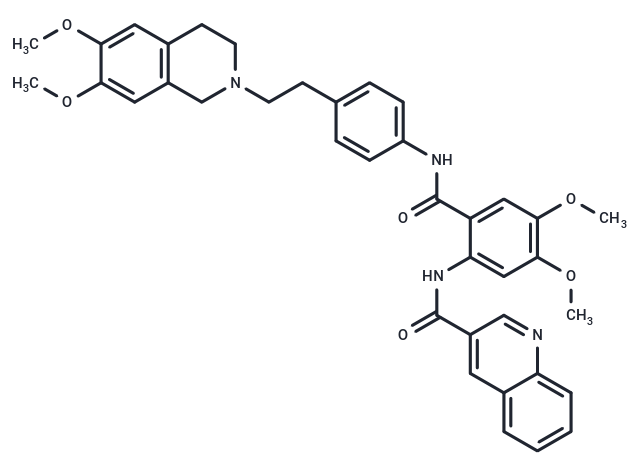Shopping Cart
Remove All Your shopping cart is currently empty
Your shopping cart is currently empty
Tariquidar (XR9576)(Kd=5.1 nM) is a specific and effective non-competitive inhibitor of P-glycoprotein. It can reverse drug resistance in MDR cell Lines.

| Pack Size | Price | USA Warehouse | Global Warehouse | Quantity |
|---|---|---|---|---|
| 5 mg | $45 | In Stock | In Stock | |
| 10 mg | $77 | In Stock | In Stock | |
| 25 mg | $132 | In Stock | In Stock | |
| 50 mg | $239 | In Stock | In Stock | |
| 100 mg | $401 | In Stock | In Stock |
| Description | Tariquidar (XR9576)(Kd=5.1 nM) is a specific and effective non-competitive inhibitor of P-glycoprotein. It can reverse drug resistance in MDR cell Lines. |
| Targets&IC50 | P-gp:5.1 nM(Kd) |
| In vitro | Tariquidar displays high-affinity binding to P-gp with Bmax of 275 pmol/mg. Tariquidar shows non-competitive interaction with the P-gp substrates vinblastine and paclitaxel. Tariquidar increases the steady-state accumulation of these cytotoxics in CHr<>/supB30 cells to levels observed in non-P-gp-expressing AuxB1 cells with EC50 of 487 nM. Tariquidar is able to inhibit the vanadate-sensitive ATPase activity of P-gp by 60-70%, with potent IC50 values of 43 nM. [1] Tariquidar may inhibit other resistance mechanisms at higher concentrations. 1 μM Tariquidar abrogates ABCG2 (BCRP)-mediated resistance to camptothecins in vitro. [2] Tariquidar potentiates the cyto-toxicity of several drugs including doxorubicin, paclitaxel, etoposide, and vincristine; complete reversal of resistance is achieved in the presence of 25- 80 nM Tariquidar. In MC26, a murine colon carcinoma cell line with intrinsic chemoresistance, the doxorubicin IC50 is fivefold lower in the presence of 0.1 μM Tariquidar (36 vs 7 nM). In murine mammary carcinoma, human small-cell lung carcinoma and human ovarian carcinoma cell lines with acquired chemotherapeutic resistance (EMT6/AR1.0, H69/LX4 and 2780 AD), the in vitro doxorubicin IC50 is 22-150-fold lower in the presence of 0.1 μM Tariquidar. P-gp inhibition persists for 23 h after removal of Tariquidar from the culture system. [3] Tariquidar restored the cyto-toxicity of doxorubicin and vinblastine in the National Cancer Institute (NCI)/ADRRES multicellular tumor spheroid model derived from the MCF7WT breast cancer cell line. [4] |
| In vivo | Tariquidar (2- 8 mg/kg p.o.) is found to significantly potentiate the antitumor activity of doxorubicin (5 mg/kg, i.v.) against MC26 murine colon carcinoma in vivo. In human carcinoma xenografts, coadministration of XR9576 (6 -12 mg/kg p.o.) fully restored the antitumor activity of paclitaxel, etoposide, and vincristine against two highly resistant MDR human tumor xenografts (2780AD, H69/LX4) in nude mice. [3] |
| Kinase Assay | Steady-state drug accumulation assay: AuxB1 and CHrB30 cells are grown to confluency in 12-well (24 mm) tissue culture dishes and the steady-state accumulation of [3H]-vinblastine is measured. Accumulation is initiated by the addition of 0.1 μ Ci [3H]-vinblastine and unlabelled vinblastine to a final concentration of 100 nM . The accumulation of [3H]-paclitaxel is measured using 0.1 μ Ci [3H]-paclitaxel and unlabelled drug to a final concentration of 1 μM . Cells are incubated in a reaction volume of 1 mL for 60 min at 37 ℃ under 5% CO2 in order to reach steady-state. The effect of the modulators XR9576 on [3H]-ligand accumulation is investigated in the concentration range 10-9 - 10-6 M. Modulators are added from a DMSO stock giving a final solvent concentration of 0.2 % (v/v). Following cell harvesting, accumulated drug is measured by liquid scintillation counting and normalized for cell protein content. Plots of amount accumulated as a function of modulator concentration are fitted with the general dose-response equation: Y={(a-b)/(1+(X/c)d)}+b Where: Y=response; a=initial response; b=final response; c=EC50 concentration; d=slope value; X=drug concentration. |
| Cell Research | Cells are seeded into 96-well plates at 800/well, in 100 μL of medium and incubated for 4 h at 37 ℃. Varying concentrations of modulator or solvent control (50 μL/well) are subsequently added and incubated for an additional 1 h before the addition of the cytotoxic drug. The cytotoxic drug (50 μL) is added to give a range of final concentrations in quadruplicate wells. After incubation for an additional 4 days, cell proliferation of adherent cells is assessed using the sulforhodamine B assay.(Only for Reference) |
| Synonyms | XR9576 |
| Molecular Weight | 646.73 |
| Formula | C38H38N4O6 |
| Cas No. | 206873-63-4 |
| Smiles | COc1cc2CCN(CCc3ccc(NC(=O)c4cc(OC)c(OC)cc4NC(=O)c4cnc5ccccc5c4)cc3)Cc2cc1OC |
| Relative Density. | 1.276 g/cm3 (Predicted) |
| Color | Yellow |
| Appearance | Solid |
| Storage | Powder: -20°C for 3 years | In solvent: -80°C for 1 year | Shipping with blue ice/Shipping at ambient temperature. | ||||||||||||||||||||||||||||||
| Solubility Information | H2O: < 1 mg/mL (insoluble or slightly soluble) Ethanol: < 1 mg/mL (insoluble or slightly soluble) DMSO: 49.5 mg/mL (76.54 mM), Sonication is recommended. | ||||||||||||||||||||||||||||||
| In Vivo Formulation | 10% DMSO+40% PEG300+5% Tween 80+45% Saline: 1 mg/mL (1.55 mM), Sonication is recommended. Please add the solvents sequentially, clarifying the solution as much as possible before adding the next one. Dissolve by heating and/or sonication if necessary. Working solution is recommended to be prepared and used immediately. The formulation provided above is for reference purposes only. In vivo formulations may vary and should be modified based on specific experimental conditions. | ||||||||||||||||||||||||||||||
Solution Preparation Table | |||||||||||||||||||||||||||||||
DMSO
| |||||||||||||||||||||||||||||||
| Size | Quantity | Unit Price | Amount | Operation |
|---|

Copyright © 2015-2025 TargetMol Chemicals Inc. All Rights Reserved.